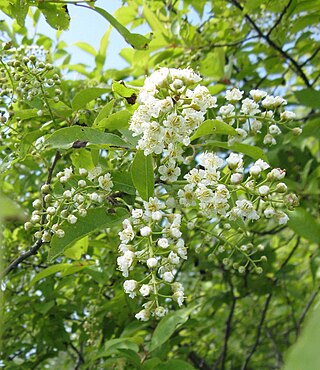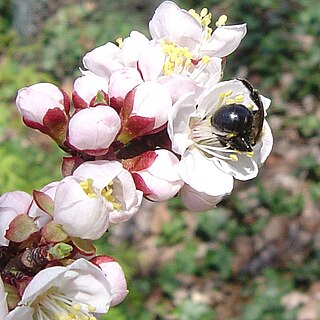
A cherry is the fruit of many plants of the genus Prunus, and is a fleshy drupe.

Prunus is a genus of trees and shrubs, which includes the fruits plums, cherries, peaches, nectarines, apricots, and almonds.

The cherry blossom, also known as a Japanese cherry or Sakura, is the flower of trees in the genus Prunus or the Prunus subgenus Cerasus. Wild species of the cherry tree are widely distributed, mainly in the Northern Hemisphere. They are common in East Asia, especially in Japan. They generally refer to ornamental cherry trees, not cherry trees grown for their fruit. The cherry blossom is considered the national flower of Japan.

Prunus virginiana, commonly called bitter-berry, chokecherry, Virginia bird cherry, and western chokecherry, is a species of bird cherry native to North America.

Prunus serotina, commonly called black cherry, wild black cherry, rum cherry, or mountain black cherry, is a deciduous tree or shrub of the genus Prunus. Despite being called black cherry, it is not very closely related to the commonly cultivated cherries such as sweet cherry, sour cherry and Japanese flowering cherries which belong to Prunus subg. Cerasus. Instead, P. serotina belongs to Prunus subg. Padus, a subgenus also including Eurasian bird cherry and chokecherry. The species is widespread and common in North America and South America.

Prunus ilicifolia is native to the chaparral areas of coastal California, Baja California, and Baja California Sur. as well as the desert chaparral areas of the Mojave desert.

Prunus cerasoides, commonly known as the wild Himalayan cherry or sour cherry, is a species of deciduous cherry tree in the family Rosaceae. It is found in southern and eastern Asia.

Prunus pensylvanica, also known as bird cherry, fire cherry, pin cherry, and red cherry, is a North American cherry species in the genus Prunus.

Prunus × yedoensis is a hybrid cherry tree between Prunus speciosa as father plant and Prunus pendula f. ascendens as mother. It is a hybrid born in Japan and one of its cultivars, Prunus × yedoensis 'Somei-yoshino' or Yoshino cherry, is one of the most popular and widely planted cherry cultivars in temperate regions around the world today. 'Somei-yoshino' is a clone from a single tree, and has been propagated by grafting all over the world. 'Somei-yoshino' inherits Edo higan's quality of blooming before the leaves unfold and it growing into a large-sized tree. It also inherits the characteristics of the Oshima cherry, which grows rapidly and has white flowers. These characteristics are favored and have become one of the most popular cultivars of cherry trees.

Prunus incisa, the Fuji cherry, is a species of flowering plant in the family Rosaceae, which gets its scientific name from the deep incisions on the leaves. It is an endemic species in Japan and grows wild in Kantō, Chūbu and Kinki regions. It is called the Fuji cherry because it grows in particular abundance around Mount Fuji and Hakone. A dainty slow-growing, early white-flowering cherry tree, this century-old cultigen from Hondo, Japan is highly regarded as an ornamental but the wood has no industrial value. It is hardy to -20 °C, and crossed with Prunus speciosa, has yielded the cultivar Prunus 'Umineko'. It is in the ornamental section Pseudocerasus of the cherry subgenus Cerasus of the genus Prunus. Ma et al. classified it in a group with Prunus nipponica.

Prunus lusitanica, the Portuguese laurel cherry or Portugal laurel, is a species of flowering plant in the rose family Rosaceae, native to southwestern France, Spain, Portugal, Morocco, and Macaronesia.

Prunus mahaleb, the mahaleb cherry or St Lucie cherry, is a species of cherry tree. The tree is cultivated for a spice obtained from the seeds inside the cherry stones. The seeds have a fragrant smell and have a taste comparable to bitter almonds with cherry notes.

Prunus prostrata is a hardy alpine shrub found naturally above about 2000 m. up to as high as 4000 m. in Israel, Algeria, Morocco, Tunisia, Syria, Turkey, Albania, Greece, Sardinia, Croatia. It grows as tall as 1 m., more typically 0.15-0.30 m., sometimes in the crevices of vertical surfaces. The branches tend to follow the surface at any angle. Flowering patches of the plant on the rocky slopes, sometimes still snow-clad, are striking to climbers.

Prunus tomentosa is a species of Prunus native to northern and western China, Korea, Mongolia, and possibly northern India. Common names for Prunus tomentosa include Nanjing cherry, Korean cherry, Manchu cherry, downy cherry, Shanghai cherry, Ando cherry, mountain cherry, Chinese bush cherry, and Chinese dwarf cherry.

Prunus sargentii, commonly known as Sargent's cherry or North Japanese hill cherry, is a species of cherry native to Japan, Korea, and Sakhalin (Russia).

Prunus avium, commonly called wild cherry, sweet cherry, gean, or bird cherry is a species of cherry, a flowering plant in the rose family, Rosaceae. It is native to Europe, Anatolia, Maghreb, and Western Asia, from the British Isles south to Morocco and Tunisia, north to the Trondheimsfjord region in Norway and east to the Caucasus and northern Iran, with a small isolated population in the western Himalaya. The species is widely cultivated in other regions and has become naturalized in North America and Australia.

Prunus caroliniana, known as the Carolina laurelcherry, Carolina cherry laurel, Carolina cherry, or Cherry laurel, is a small evergreen flowering tree native to the lowlands of Southeastern United States, from North Carolina south to Florida and westward to central Texas. The species also has escaped into the wild in a few places in California.

Prunus nipponica, also called Japanese alpine cherry, is a shrub which originates from the islands of Hokkaido and Honshu, Japan. It grows to a height of about 5 meters (16 ft) and can grow in sandy, loamy, and clay soils.

Prunus mandshurica, also called Manchurian apricot and scout apricot, is a tree in the genus Prunus.

Corylus jacquemontii is a species of hazel, found in Asia, within the Himalayas and from Afghanistan through to W. Nepal. It is a small tree or shrub, with grey bark, ovate or obovate (teardrop-shaped) leaves, small flowers and small edible nuts, grouped in small clusters.





















